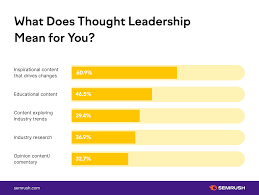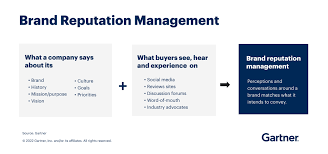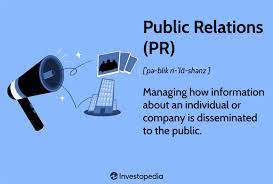Unleashing the Power of Thought Leadership: Shaping the Future with Expertise and Innovation
Thought Leadership: Shaping the Future Through Expertise and Innovation
In today’s rapidly changing world, standing out from the crowd and establishing credibility is more important than ever. This is where thought leadership comes into play. Thought leadership has become a crucial strategy for individuals and businesses to differentiate themselves, build trust, and influence their industries.
So, what exactly is thought leadership? It goes beyond simply sharing knowledge or expertise. Thought leadership is about being at the forefront of innovation, challenging conventional wisdom, and providing valuable insights that shape the future of an industry or field.
Thought leaders are individuals or organizations that are recognized as authorities in their respective domains. They possess deep knowledge, experience, and a unique perspective that sets them apart from others. By consistently delivering valuable content and ideas, they become trusted sources of information and inspiration.
One of the key aspects of thought leadership is sharing insights openly with others. Thought leaders understand that by sharing their expertise, they can contribute to the growth and development of their industry as a whole. They publish articles, speak at conferences, host webinars, engage in social media discussions, and actively participate in relevant communities.
However, thought leadership is not just about self-promotion; it’s about adding value to the conversation. Thought leaders offer fresh perspectives on industry trends, provide innovative solutions to common challenges, and inspire others to think differently. By doing so, they position themselves as trusted advisors who can guide others towards success.
Thought leadership also plays a vital role in building trust with stakeholders – be it clients, customers, employees or investors. When individuals or businesses consistently demonstrate their expertise through thought leadership initiatives, they establish credibility within their industry. This credibility fosters trust among stakeholders who are more likely to seek their guidance or engage in business with them.
Furthermore, thought leadership can lead to increased visibility and recognition both locally and globally. As thought leaders share valuable insights through various channels such as blogs or social media, their influence grows. They become go-to sources for journalists, industry publications, and event organizers who seek their perspectives. This exposure not only enhances their personal or brand reputation but also opens doors to new opportunities.
To become a thought leader, it’s crucial to stay ahead of the curve. Thought leaders continuously invest in learning and staying updated on industry trends, emerging technologies, and best practices. They actively engage with peers and experts to exchange ideas and challenge existing norms. By doing so, they remain at the forefront of innovation and maintain their relevance in a rapidly evolving landscape.
In conclusion, thought leadership is a powerful tool for individuals and businesses to differentiate themselves from the competition. It is about sharing expertise, challenging norms, and shaping the future of an industry. By becoming trusted advisors through valuable insights and innovative ideas, thought leaders can build credibility, influence stakeholders, and drive positive change. So embrace thought leadership as a strategic approach to establish yourself as an authority in your field and make a lasting impact on your industry.
Frequently Asked Questions about Thought Leadership: Answers and Examples
- What is thought leadership example?
- What is the meaning of thought leadership?
- What is thought leadership and why is it important?
- What is the focus of thought leadership?
- What is an example of thought leadership?
- How do you demonstrate thought leadership?
What is thought leadership example?
One example of thought leadership is Elon Musk, the CEO of Tesla and SpaceX. Musk is widely recognized as a thought leader in the fields of electric vehicles and space exploration. Through his visionary ideas, innovative technologies, and bold initiatives, he has transformed these industries and influenced the way people perceive and interact with them.
Musk consistently shares his expertise and insights through various channels, including social media platforms like Twitter. He uses these platforms to communicate directly with his followers, sharing updates on his companies’ progress, discussing industry trends, and even engaging in debates.
Additionally, Musk’s thought leadership is evident in his ability to challenge conventional wisdom. For instance, he has been a vocal advocate for electric vehicles when many doubted their feasibility. By pushing boundaries and investing heavily in research and development, Musk has successfully positioned himself as a leading authority on sustainable transportation.
Another example of thought leadership is Simon Sinek, a renowned author and speaker known for his work on leadership and organizational culture. Sinek’s TED Talk on “Start with Why” became one of the most-watched TED Talks of all time, propelling him to thought leader status.
Through his books, talks, and consulting work, Sinek shares powerful insights into what makes great leaders and organizations successful. He challenges traditional thinking by emphasizing the importance of purpose-driven leadership that inspires others to take action.
Sinek’s thought leadership has had a profound impact on how individuals and businesses approach their work. His concepts have influenced countless leaders to focus on defining their organization’s purpose rather than solely focusing on profit. This shift in mindset has led to more engaged employees, loyal customers, and sustainable growth for many companies.
These examples demonstrate how thought leaders use their expertise, innovative ideas, and willingness to challenge norms to shape industries or fields. Their influence extends beyond their own organizations as they inspire others to think differently and drive positive change.
What is the meaning of thought leadership?
Thought leadership refers to the position of being recognized as an authority or expert in a particular field or industry. It goes beyond expertise and knowledge; it involves actively sharing valuable insights, innovative ideas, and forward-thinking perspectives that shape the future of that field. Thought leaders are individuals or organizations who are seen as trusted sources of information and inspiration, influencing others through their unique perspectives and contributions. Thought leadership is about leading conversations, challenging conventional wisdom, and driving positive change within an industry or domain.
What is thought leadership and why is it important?
Thought leadership refers to the practice of individuals or organizations establishing themselves as experts and authorities in their respective fields. It involves sharing valuable insights, innovative ideas, and industry knowledge to shape the future, influence others, and drive positive change.
There are several reasons why thought leadership is important:
- Differentiation: In a crowded marketplace or industry, thought leadership helps individuals and businesses stand out from the competition. By showcasing their deep knowledge and unique perspective, they distinguish themselves as leaders in their field.
- Credibility and Trust: Thought leaders are seen as trusted sources of information and expertise. By consistently delivering valuable content and insights, they build credibility among their audience, clients, customers, employees, investors, and other stakeholders.
- Influence: Thought leaders have the power to influence others within their industry or field. Their ideas and perspectives shape conversations, challenge existing norms, and inspire innovation. They have the ability to drive change by providing guidance and offering solutions to common challenges.
- Networking Opportunities: Thought leadership opens doors to new connections and collaborations. As thought leaders share their expertise through various channels such as speaking engagements or writing articles, they attract attention from peers, journalists, event organizers, and potential partners.
- Business Growth: Thought leadership can directly contribute to business growth. When individuals or organizations establish themselves as authorities in their field, they become go-to resources for clients or customers seeking guidance or solutions. This can lead to increased visibility, brand recognition, customer loyalty, and ultimately drive revenue growth.
- Personal Branding: For individuals especially, thought leadership enhances personal branding by positioning them as experts in their domain. This can lead to career advancement opportunities such as speaking engagements or consulting roles.
- Industry Development: Thought leaders play a crucial role in advancing industries by sharing insights openly with others. They contribute to the growth of knowledge within their field by challenging conventional thinking and driving innovation forward.
In summary, thought leadership is important because it helps individuals and businesses differentiate themselves, build credibility and trust, influence others, open doors to new opportunities, drive business growth, enhance personal branding, and contribute to the development of their industry. By sharing valuable insights and innovative ideas, thought leaders can make a lasting impact and shape the future of their field.
What is the focus of thought leadership?
The focus of thought leadership is to establish oneself or a business as a recognized authority and influencer in a specific industry or field. Thought leaders aim to provide valuable insights, innovative ideas, and fresh perspectives that shape the future of their industry. They focus on sharing expertise openly, challenging conventional wisdom, and offering solutions to common challenges. The ultimate goal is to build trust, credibility, and influence among stakeholders by consistently delivering high-quality content and positioning themselves as trusted advisors.
What is an example of thought leadership?
One notable example of thought leadership is Elon Musk, the CEO of Tesla and SpaceX. Musk has consistently demonstrated his expertise and innovative thinking in the fields of electric vehicles and space exploration. Through his bold vision and groundbreaking ideas, he has positioned himself as a thought leader in these industries.
Musk’s thought leadership is evident in his public statements, interviews, and social media presence. He shares insights on the future of sustainable transportation, renewable energy, and space colonization. His ideas have challenged traditional automotive and aerospace norms, inspiring others to think differently about these sectors.
Furthermore, Musk actively participates in industry discussions and events, where he presents his ideas and engages with other experts. His contributions have not only influenced the development of electric vehicles but also sparked conversations around the possibilities of interplanetary travel.
Musk’s thought leadership extends beyond just sharing ideas; he backs them up with tangible actions. By successfully launching reusable rockets with SpaceX and revolutionizing the electric vehicle market with Tesla, he has demonstrated that his visionary thinking can translate into real-world impact.
Through his thought leadership initiatives, Elon Musk has not only established himself as an authority in these industries but also attracted a loyal following of supporters who believe in his vision for a sustainable future. His influence extends beyond his own companies as he continues to inspire entrepreneurs, engineers, and innovators worldwide.
Elon Musk serves as an excellent example of how thought leadership can shape industries through expertise, innovation, and a commitment to challenging norms. His ability to share valuable insights while driving tangible change exemplifies the power that thought leaders possess in influencing their respective fields.
How do you demonstrate thought leadership?
Demonstrating thought leadership involves several key strategies and actions. Here are some ways to showcase your expertise and establish yourself as a thought leader:
- Consistently produce valuable content: Create and share insightful articles, blog posts, whitepapers, or research papers that address industry challenges, provide innovative solutions, or offer unique perspectives. Focus on delivering high-quality content that educates and inspires your target audience.
- Engage in public speaking: Seek opportunities to speak at conferences, industry events, webinars, or panel discussions. Share your knowledge and experiences with a wider audience, positioning yourself as an authority in your field.
- Contribute to industry publications: Write guest articles for reputable publications within your industry. This allows you to reach a broader audience and gain recognition as a thought leader.
- Participate in social media discussions: Engage in meaningful conversations on platforms like LinkedIn, Twitter, or relevant forums. Share valuable insights, answer questions, and contribute to ongoing discussions within your industry.
- Host webinars or workshops: Organize online sessions where you can share your expertise in a more interactive format. Offer practical advice, case studies, or actionable tips that help others navigate challenges within your field.
- Collaborate with other thought leaders: Seek opportunities to collaborate with other experts in your industry through joint projects, interviews, or co-authored articles. This not only expands your network but also reinforces your credibility by association.
- Provide mentorship or coaching: Share your knowledge and guide others by offering mentorship programs or coaching services. Helping others succeed demonstrates leadership while solidifying your position as an expert in the field.
- Leverage social proof: Showcase testimonials from satisfied clients or customers who have benefited from your insights or solutions. Positive feedback from those who have experienced the value of your expertise enhances credibility and builds trust among potential followers.
- Stay updated with industry trends: Continuously invest time in learning and staying informed about the latest industry trends, emerging technologies, and best practices. This allows you to offer fresh insights and positions you as someone who is at the forefront of your field.
- Network and engage with peers: Attend industry events, join professional associations, or participate in online communities relevant to your niche. Actively engage with peers, share knowledge, and contribute to discussions. Building relationships with other thought leaders can amplify your impact and open doors to new opportunities.
Remember, thought leadership is not achieved overnight. It requires consistent effort, a commitment to excellence, and a genuine passion for sharing knowledge. By demonstrating these qualities through various channels, you can establish yourself as a trusted authority in your industry.





